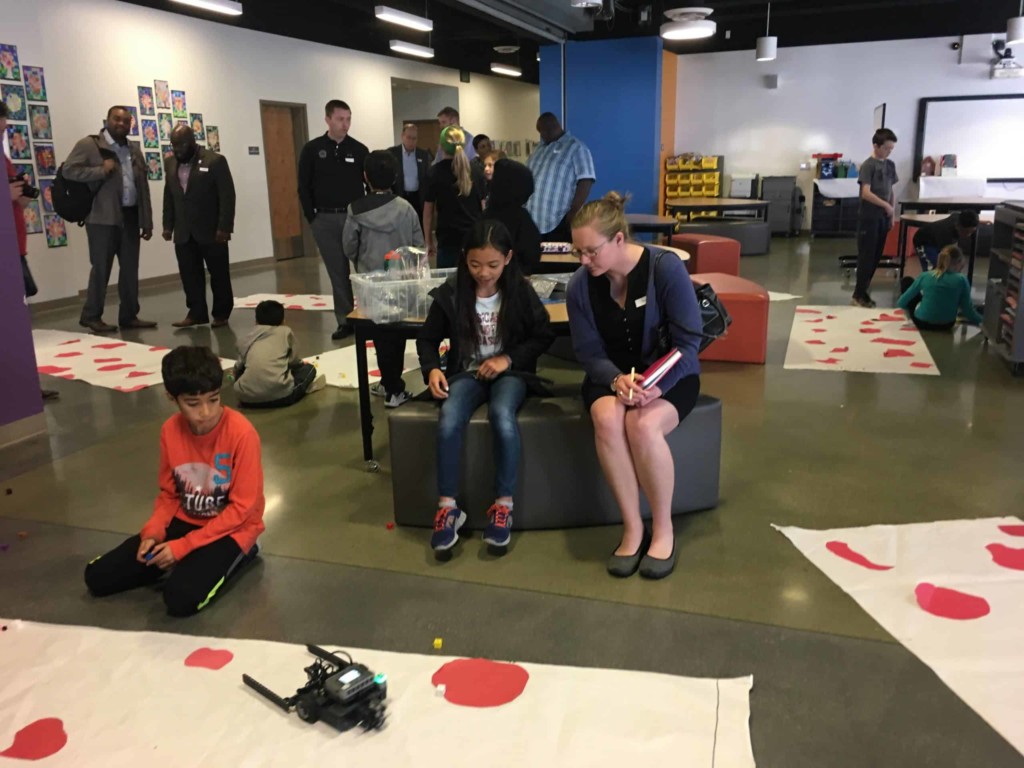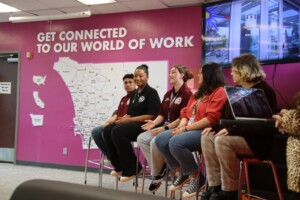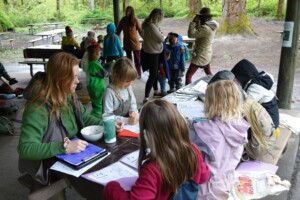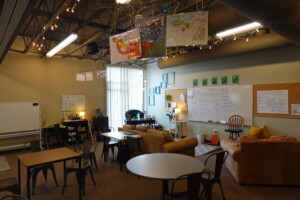Elementary & Middle Schools Worth Visiting

Here at Getting Smart, we believe school visits are the best form of professional learning. Based on a couple thousand school visits, and with help from colleagues and readers, we’ve compiled a list of elementary and middle schools that can give educators a better sense of what’s possible. This list includes schools that achieve extraordinary results for underserved communities, create powerful learning experiences, and/or have innovative school models.
Elementary Schools
Horace Mann Elementary School, in northwest Washington D.C., is a student-centered personalized learning environment serving a diverse student body. The modernized facility reflects thoughtful values: Collaboration and Connection, Sustainability and Stewardship, and Choice and Invention. (See our feature, and listen to our podcast with principal Liz Whisnant.)

Epic Elementary School, Liberty School District, a project-based school located in what used to be the district office.
Serving 300 learners in the renovated district office, the EPiC architecture features double classrooms and partner teaching. Many of these “studios” have big roll-up doors (below) and share common space (like the mini-theater below) and quiet small group rooms. See feature.
KIPP Empower in LA (see profile and video) was the first blended school in the KIPP network. All seven elementary schools in this region have implemented similar models with success. Like other KIPP schools, Empower promotes character strengths and social intelligence.
Ingenuity Prep, in Washington, D.C, is a NGLC winner that serves PreK3-2nd grade students. They plan to grow to PreK3-3rd next year with a four-tiered staffing approach (from resident to master teacher) and small-group blended learning instruction.
Bricolage Academy in NOLA (@BricolageNOLA) is a new, diverse, active learning elementary (K-4 growing to K-8) school founded by Josh Densen. A recent Mini Maker Faire builds on an innovation culture.

Success Academy is redefining success in public education with 28 elementary schools, three middle schools and one high school in NYC. Visit to learn about sophisticated teacher development, inspiring science instruction and a powerful culture. CEO Eva Moskowitz explains, “We have a culture of daily mastery–we believe children should intellectually struggle with challenging content and the teachers should insist on mastery.”
Achievement First operates 30 schools in Brooklyn, Providence and Connecticut. The flagship Amistad Academy “opened in New Haven in 1999 to prove that urban students can achieve at the same high levels as their affluent suburban counterparts.” A K-3 school (growing to K-4), AF Providence Mayoral Academy, is worth a visiting to see “joyful, student-centered, rigorous instruction.”
KIPP Ascend Primary in Chicago has a station rotation model during math and literacy blocks. They use Lexia Core5, Reading Assistant, ST Math, Think Through Math and Khan Academy.
Bracken STEAM Academy is an award winning magnet K-5 school in north Las Vegas (profiled here). Grade level teams coordinate a long list of digital resources.
Gilroy Prep is a high performing elementary school (K-8 in 2018) and the anchor of Navigator Schools. You’ll see a combination of direct instruction and a lab rotation model.
Cleveland Elementary School (featured here) was the lowest performing elementary school in Santa Barbara until they launched a blended math program powered by DreamBox Learning. The adaptive math program is used in a station rotation model.
Cornerstone Madison-Carver Academy is a K-6 school in Detroit (featured here). Cornerstone features a lab rotation in primary grades and a class rotation in intermediate grades, and a strong culture and well developed character development program for all students.
All students at Wade King Elementary School in Bellingham, Washington, are learning Chinese. Students are able to work at their own pace, and benefit from individualized instruction, access from home, and coaching from a native speaker. King Elementary was featured in our recent paper, The Next Generation of World Language Learning.
Colvin Run Elementary School in Fairfax County Virginia expanded their existing Spanish curriculum in blended classrooms. After 13 weeks, 90% of the students improved oral proficiency by at least one level. They also use Rosetta Stone to create an independent study program for languages like Chinese (featured here).
KM Explore is one of three very interesting district-sponsored charter schools west of Milwaukee. The open-plan multi-age blend features high engagement projects. They also figured out what to do with those old textbooks.

Hartland School of Community Learning (profiled here), also west of Milwaukee, is a grade 3-5 multi-age charter school that uses trimester targets to set weekly and monthly academic goals for themselves to guide their learning. Each day, students stop, drop and reflect for the last 40 minutes of the day.
KIPP Austin Obras features a dual language school that uses a station rotation model in both Spanish and English (ST Math and Istation). (See Hechinger’s feature.)
St. Louis Language Immersion Schools (@STLGlobalKids) include French, Spanish and Chinese immersion elementary schools, and plan to open an IB secondary school next year. We agree: every student should be globally competent and world language fluent.
Hanley Elementary is one of five Aspire Public Schools schools in Memphis. Their proven “College for Certain Model” offers a “rich STEM-focused education, individualized technology rich learning opportunities, and explicit instruction in computer coding skills.” The updated rotation model (profiled here) features i-Ready and DreamBox Learning. For the full story read Liz Arney’s book, Go Blended.
Cornerstone Academy Preparatory School, San Jose, was a traditional high performing elementary school founded in the Building Excellent Schools network that was recently transformed to blended learning and is getting exceptional results with a low income, ELL population.
Quitman Elementary School in Newark is making good strides in a tough place by starting with great expectations. Blended partners include Education Elements, i-Ready, GoMath, Reading Eggs, Study Island, Newsela and BrainPOP.
Randle Highlands in Washington DC worked with Education Elements to deploy blended learning featuring ST Math, Lexia, MyON and i-Ready. Each school day has 90 minutes of blended math instruction and 120 minutes of blended ELA instruction. (See our summary of the DC approach and an AEI paper that details blended learning in DC featuring Kramer Middle School and Ketcham Elementary School.)
Uinta County School District in Evanston, Wyoming has four elementary schools that use rotation and flexible learning models to empower their K-5 students to own their learning. They use a variety of software tools including Google Apps, NewsELA and NoRedInk.
Lake Forest Elementary School, Fulton County (Atlanta) is a high poverty, high mobility, high ELL school. It’s a great example of blended learning, student access, student-centered instruction, personalized professional development, and a great school culture.
Rocky Mountain Prep (@RockyMtnPrep) is a growing network of elementary public charter schools in Denver. The RMP Creekside campus serves P-5 students in a class rotation model (featured here). Teacher fellows can earn a Masters in Teaching from Relay while working with a lead teacher.
Barack Obama Charter School in Compton is part of the Ingenium network and uses the personalized, standards-based model first developed in Chugach, Alaska (see seven part series). Teachers serve as coaches in the system where proficiencies as assessed, verified and documented. Students spend 120 minutes per week using software such as DreamBox, Study Island and Reading Eggs, which has been helpful for practicing skills and getting rapid feedback (featured on CompetencyWorks).
Hawk Ridge Elementary in Charlotte was transformed through the development of a shared vision of personalized learning, a culture of trust, and a lot of professional learning. Key features of the school model include a Genius Hour, personalized pathways, team teaching and opportunity culture staffing (profiled here).

Encinitas Union School District, north of San Diego, features nine K-6 schools focused on personalized learning, health and wellness.
Herrera Elementary in Houston is an IB school tech magnet that offers dual language. The walls are covered with student work and vibrant with bright colors. There was a blend of individual, partner and group work apparent in every classroom. The kids love the farm animals in the courtyard (but if you visit, watch out for the goat).
New Emerson Elementary School is a demonstration site for Mesa County Valley School District 51, a district featured by CompetencyWorks for their high engagement transition to personalized and competency-based learning. Principal Terry Schmalz explained, “It is a powerful process when community members and parents and educators come together to create a shared vision for a school. It took us a year because we wanted rich participation. We don’t do buy-in, we do shared leadership.” (Listen to our podcast with their district leaders.)
Mukilteo Elementary, north of Seattle, makes great use of the Leader in Me program to empower student leadership. They finish each year with a family portfolio picnic where they review quality student work. Students also help to develop a nature preserve with trails and an outdoor classroom (see feature).

Rocketship Spark Academy in San Jose is housed in a beautiful building opened in 2013 and authorized by Franklin-McKinley School District. Rocketship uses a flex learning lab model to extend the day and the reach of great teachers. Content includes DreamBox, ST Math, i-Ready and Rosetta Stone. (See Preston Smith on Investing in the Art of Teaching.)
K-8 Schools
Design39, in Poway School District north of San Diego, is a spectacular K-8 school featuring design thinking and personalized learning (featured here). Check out this podcast episode with Joe Erpelding, formerly of Design 39 on why this is such a magical school and how they live into their motto: “Life ready thought leaders who elevate humanity.”

West Belden is a K-8 school in Chicago’s Belmont-Cragin neighborhood and part of the Chicago International Charter School network. The NGLC grant winner (see profile) personalizes learning using flexible environments, learner profiles, personalized learning plans and competency-based progress.
Cesar E. Chavez Multicultural Academic Center is a neighborhood P-8 in Chicago’s Back of the Yards neighborhood on the south side. Despite nearly 100% poverty and nearly half of the students new to English, the school has been a top academic performer in Chicago for the last five years. Principal (and data ninja) Barton Dassinger was a teacher at Chavez and has kept a veteran staff focused on getting better every year.
National Teachers Academy in Chicago, managed by AUSL, is a high poverty school that serves as a training academy. (See EdWeek feature on the first chromebook classroom in Chicago Public Schools.)
Aspire ERES Academy in Oakland (profiled here) uses ST Math, i-Ready, Achieve 3000, Accelerated Reader and Think Through Math in a station rotation model. Serving 16,000 students in 40 schools, Aspire is one of the nation’s highest performing low-income school systems.
Da Vinci Connect is a project-based NGLC winning school in Hawthorne, California (profiled here). Students usually spend two days per week on campus and have another optional day on campus for electives.
Burley School is a Chicago literature, writing and technology magnet school. Visitors see students discussing, reading, thinking, exploring, questioning, experimenting, creating and collaborating. Students have access to iPads and laptops and a full art and music program.
Acton Academy is a student-centered microschool in Austin. On a recent visit, 35 middle school students, with no adult supervision, were designing an electric grid for a smart city. There are about 200 global replications worldwide. (See our feature.)

Caliber Beta opened in 2014 in Richmond, California, with personalized learning plans, a flexible rotation model for math and English and project-based learning for science and social studies. Students participate in computer programming, engineering and robotics classes.
Washington Elementary School in Lindsay Unified School District (outside of Fresno) is doing great things with blending and competency. They use multiple resources to assist students in pursuing personal learning plans and students transition as they demonstrate competency at the course level–a great example of developing and engaging student agency and social emotional learning. (Watch district video and see feature in iNACOL personalized learning report.)
Magnolia Montessori for All is a champion of both blended learning and the potential of a school dedicated to true college and career readiness for all its students. The school opened its doors as a public charter in the fall of 2014 with grades pre-K through 3. It will reach full capacity in 2019 with students through grade 8. It is a unique blend of Montessori practice and the high expectations of the “no excuses” charter model.
Environmental Charter School at Frick Park in Pittsburgh uses their theme to build systems thinkers, explore complexity and develop problem solving skills.

Bella Romero Academy is a K-8 school on two campuses in Greeley Colorado. The 6-8 classrooms launched a personalized learning model across all subject areas with support from their platform partner Education Elements. The instructional model looks different in each grade level as the teachers gradually release more responsibility to students each year.
Arthur Ashe Charter School in New Orleans (profiled here) is operated by FirstLine Schools. The lab rotation model incorporates Achieve 3000, Accelerated Reader, Think Through Math and ST Math.
Dolores T Aarons Academy is a P-8 school operated by ReNEW Schools, turnaround specialists in New Orleans. Intermediate blends use ST Math and performance groups in reading. Middle grades feature 1:1 Chromebooks and big integrated blogs. DTA has improved from F to C and is shooting for an A rating.

Urban Montessori Charter School, an NGLC in Oakland grantee, combines Montessori’s pedagogy with Design Thinking and Arts Integration.
Crossroads Academy-Central St., Kansas City, is a blended and project-based school that embraces the opportunity of an urban setting.
St. Ann, the Personal School is a model Blended Learning school from the Archdiocese of New York. Known as The Personal School, their focus is meeting the needs of every student.
Mandarin Immersion Magnet School in Houston is a must-see with a state-of-the-art facility, cohesive culture, blended learning and student supports.

Middle Schools
KIPP Ascend Charter School and KIPP Create College Prep in Chicago features a large and flexible lab rotation giving teachers the flexibility of either being in the lab, working with small groups in their classrooms, or something else entirely.
Bate Middle School, Danville, Kentucky, (profiled here) is a turnaround story. The staff-developed innovation plan focused on challenge-based learning, performance-based assessments and positive habits of mind. Check out this great trip report from former superintendent Carmen Coleman.
At Messalonskee Middle School in Maine, students have Learning Goal Time every day, with a full two hours once a week to work on assignments and get the extra help they need. Chris Sturgis has featured the school on CompetencyWorks and in this brief.
Blanca Alvarado Middle School, of Alpha Public Schools (profiled here), is in San Jose. Alpha uses Compass Learning, Achieve 3000 and ST Math content on the Education Elements platform with MAPS and MasteryConnect assessments. Students spend about 50% of their time in the station rotation model online.
James Madison Middle School in Oakland (profiled here) is one of the blended learning pilot projects supported by the Rogers Family Foundation and Education Elements. Madison teachers use a two-group in-class rotation model. Math content includes DreamBox, Mangahigh and Khan Academy.
KIPP Washington Heights Middle School in NYC is also worth a visit. In addition to ST Math and Khan Academy, they use Newsela and Read180/System44 in a combination of lab rotation and station rotation models at different points in the day. (See lessons from KIPP Math Blends).
Quest to Learn is a NYC game-based charter middle school (profiled here) created with the Institute of Play. Game-based content includes, Minecraft, Gamestar Mechanic, Atmosphir and Mangahigh.
Ranson IB middle school (@RansonIBMS) is part of Charlotte Mecklenburg‘s Project LIFT to create an Opportunity Culture and extend the reach of the best teachers. A great blog from Romain Bertrand (@htdcompletely) outlines five lessons from their efforts to personalize math instruction and notes that “Compass Learning Odyssey or Dreambox Learning help you better know what each of your students really need.”
Spurgeon Intermediate School in Santa Ana integrates project-based learning with lab rotation in a newly rebuilt flexible learning space (see pictures and video on Facebook). Gooru holds all of their Common Core units of study.
Advanced Learning Academy is a new Santa Ana lab school. It’s “high-tech, project-based, and STEM” focused. The blended and competency-based school opened with grades 4-6 and will grow a grade a year to grade 12 (featured here).
Whittemore Park Middle School was designated in need of improvement, and launched a turnaround process in 2013. Working with Education Elements, Whittemore won an NGLC grant. This Horry County School (near Myrtle Beach) is a great example of community collaboration and district led digital conversion. (Check out their Personalized Digital Learning Initiative, a feature on the district’s Whole Village strategy, and a recap of blended learning decisions.)
Achievement First Bushwick Middle School in Brooklyn is blending 90 minutes of math instruction and more than two hours of reading instruction every day. The talented principal is a former math teacher, has an MBA and was an BCG education consultant.
Piedmont Middle School, a rural school between Atlanta and Birmingham, is an NGLC and Verizon Innovative School winner that has completely restructured their day. The model has three main goals: advanced mastery, relevance and student ownership (read the NGLC profile).
KIPP Central City Academy is one of 10 KIPP schools in New Orleans. The 5-8 school opened in 2007. A great Chromebook learning lab features St Math in 5-6, and ThinkThroughMath and iXL in 7-8. Achieve3000 and Quizlet help build vocab in support of writing across the curriculum. In the spirit of the city, KCCA features a great marching band.
Camp Creek Middle School of Fulton County Atlanta is a high poverty, high mobility school implementing NewClassrooms‘ Teach-to-One Math model for a group of almost 800 middle school students. Math has become personalized and students progress at their own pace while engaging in various instructional modalities.
KIPP Prize is a third year school in east San Jose featuring personalized learning, character development and cultural enrichment. As one of 11 Bay Area KIPP schools, it was named a Top Bay Area Public School for Underserved Students.
Grant-Beacon Middle School is a transformed middle school in Denver featuring blended learning, character development, and extended learning opportunities (featured here). Kepner-Beacon Middle School is the second school in the network (featured here). Both have great student ambassadors.

Houston’s A+ UP is an innovative flex blend middle school with six museum partnerships (featured here). Launched as private microschool pilot, the school expanded as a two campus charter school.
Fruita Middle School is one of two model PLC schools in Colorado and a leader in Grand Junction’s District 51 transition to performance-based learning. (See PLC video and podcast with district leaders)
Elementary + Middle Pairs
The 200 school New Tech Network (NTN) includes a growing number of project-based, STEM-focused middle and elementary schools. The movement began in the Evergreen School District in San Jose with Katherine Smith Elementary, a joyful project-based school with the best student ambassador program we’ve experienced. Bulldog Tech (below) is a purpose-built middle school with double classrooms ideal for integrated project-based learning. (See our feature and listen to Bulldog teachers and students)

Humes Preparatory Academy and Klondike Preparatory Academy in Memphis are operated by Gestalt Community Schools (profiled here) and feature a rich program of blended, project-based and social-emotional learning.
AF Greenfield Schools includes Elm City College Prep Elementary, a Connecticut School of Distinction (check out their expeditions), and Elm City College Prep Middle. They are piloting the Cortex platform, and student-centered and technology-enhanced learning.
Strive Prep Ruby Hill, a third year elementary school, and Strive Prep Federal, a 6-8 middle school, are part of the Strive network of 11 schools serving 3,500 students in Denver. The personalized learning network is building out K-12 feeder patterns in three low-income neighborhoods.

International Bonuses
Inspired by Rocketship, the 21 SPARK Schools in Johannesburg and Cape Town South Africa feature blended and extended learning and design thinking (featured here).

Saunalahti School in Espoo, Finland features student-centered learning in drama, art, music, literature, handicrafts, dance and P.E.

For more great schools to visit, check out our Middle & High Schools Worth Visiting Smart List, and check out our other recent Smart Lists: 30 School Districts Worth Visiting and 75 Top School and Charter Networks.
We’re sure we missed hundreds of great schools. Who did we miss? Share in the comments section below.
Stay in-the-know with all things EdTech and innovations in learning by signing up to receive the weekly Smart Update. This post includes mentions of a Getting Smart partner. For a full list of partners, affiliate organizations and all other disclosures, please see our Partner page.







Susan Maynor
Check out EPiC Elementary in Liberty Public Schools. K-5 project-based learning environment. http://epic.liberty.k12.mo.us/. Here is our iBook that shares more about our story and journey to re-imagine education for everyone! https://itunes.apple.com/us/book/epic-elementary/id1060160538?mt=11
Replies
Tom Vander Ark
looks cool, thanks Susan!
Erin Teeter
Pittsburgh has an H at the end of it. It's weird; I know. But it does.
Replies
Catherine Wedgwood
Thanks for catching that typo, Erin! We fixed it. :)
Andrew Collins
There are some pretty amazing innovative schools in Arizona, too!
Replies
Tom Vander Ark
Got AZ schools on the high school list. What elementary schools should we visit?
Bruce William Smith
A primary school model worth checking out would be one from Singapore, such as its international school in Hong Kong; while for middle school, I recommend the Deutsch-Französisches Gymnasium/Lycée Franco-Allemand in Freiburg, an interesting experiment in advancing international peace among former enemies.
Replies
Tom Vander Ark
Thanks Bruce
J. Pugh
DC Prep Public Charters Schools in Washington DC. Awesome Network of schools for students!
Tom Vander Ark
look forward to visiting Future Public School in Boise, k-3 engineering focused school https://www.futurepublicschool.org/
Tom Vander ark
Looking forward to visiting design focused City & Country in NYC https://www.cityandcountry.org/page
Kelly
Anastasis Academy is an innovative k-8 school in Colorado worth visiting!